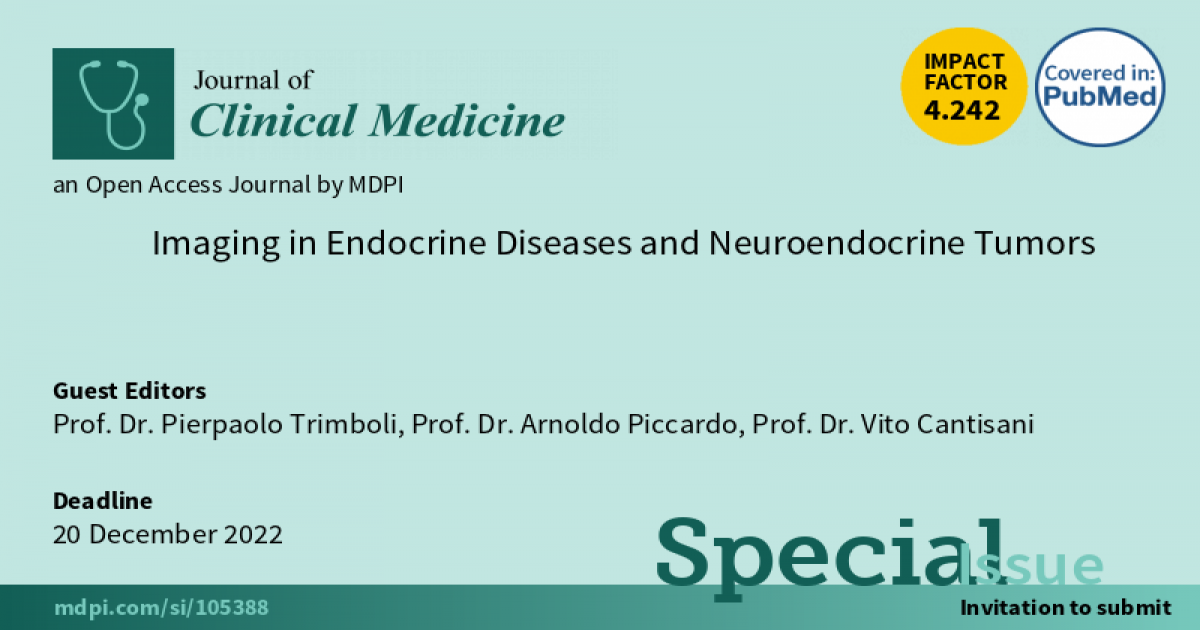Imaging in Endocrine Diseases and Neuroendocrine Tumors
A special issue of Journal of Clinical Medicine (ISSN 2077-0383). This special issue belongs to the section "Endocrinology & Metabolism".
Deadline for manuscript submissions: closed (20 December 2022) | Viewed by 5629

Special Issue Editors
2. Faculty of Biomedical Sciences, Università della Svizzera Italiana (USI), Lugano, Switzerland
Interests: thyroid nodule; thyroid ultrasound; thyroid biopsy; thyroid cancer
Special Issues, Collections and Topics in MDPI journals
Interests: nuclear medicine; radioactive iodine therapy; differentiated thyroid cancer; PET/CT; pediatrics; neuroblastoma; 131I MIBG therapy
Special Issues, Collections and Topics in MDPI journals
Interests: diagnostic radiology; ultrasound imaging; computed tomography; magnetic resonance; imaging; medical imaging; diagnostic imaging; radiography
Special Issue Information
Dear Colleagues,
Imaging is frequently pivotal to essential in the management of endocrine diseases and neuroendocrine tumors. During the last two decades, all of us experienced the advent of high-resolution morphological imaging procedures as well as new tools of molecular imaging in several fields of clinical interest. Firstly, this technological improvement implied a higher diagnostic accuracy in disclosing endocrine-related disorders. Furthermore, this relevant advancement in diagnostics has significantly and positively influenced the management and decision making of patients with suspected or/and ascertained malignant or benign endocrine diseases. Indeed, all the areas of endocrinological expertise (i.e., thyroid, parathyroid, pituitary gland, adrenal glands, as well as neuroendocrine tumors) have taken advantage of this imaging development. This Special Issue wishes to summarize the results of the interaction between clinical endocrinologists and imaging procedures, with particular attention to those more recently introduced.
Prof. Dr. Pierpaolo Trimboli
Prof. Dr. Arnoldo Piccardo
Prof. Dr. Vito Cantisani
Guest Editors
Manuscript Submission Information
Manuscripts should be submitted online at www.mdpi.com by registering and logging in to this website. Once you are registered, click here to go to the submission form. Manuscripts can be submitted until the deadline. All submissions that pass pre-check are peer-reviewed. Accepted papers will be published continuously in the journal (as soon as accepted) and will be listed together on the special issue website. Research articles, review articles as well as short communications are invited. For planned papers, a title and short abstract (about 100 words) can be sent to the Editorial Office for announcement on this website.
Submitted manuscripts should not have been published previously, nor be under consideration for publication elsewhere (except conference proceedings papers). All manuscripts are thoroughly refereed through a single-blind peer-review process. A guide for authors and other relevant information for submission of manuscripts is available on the Instructions for Authors page. Journal of Clinical Medicine is an international peer-reviewed open access semimonthly journal published by MDPI.
Please visit the Instructions for Authors page before submitting a manuscript. The Article Processing Charge (APC) for publication in this open access journal is 2600 CHF (Swiss Francs). Submitted papers should be well formatted and use good English. Authors may use MDPI's English editing service prior to publication or during author revisions.
Keywords
- thyroid
- parathyroid
- pituitary gland
- adrenal glands
- neuroendocrine tumors
- ultrasonography
- computed tomography (CT)
- scintigraphy
- single-photon emission computed tomography (SPECT)
- positron emission tomography (PET)
- magnetic resonance imaging (MRI)







